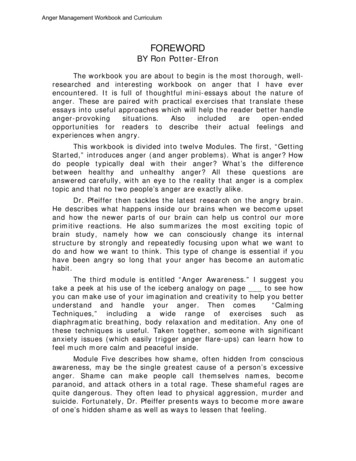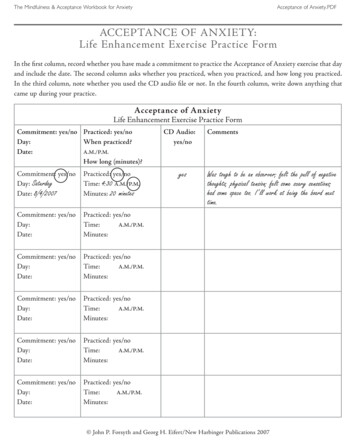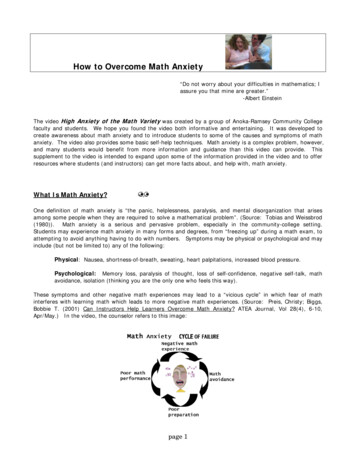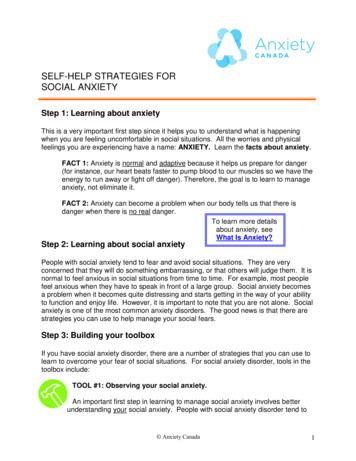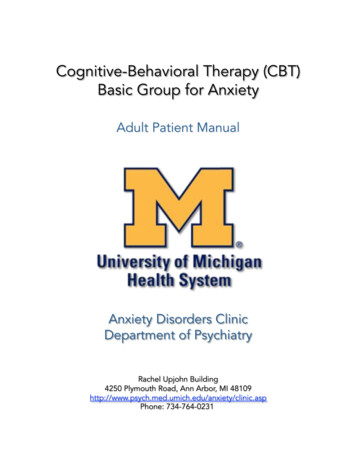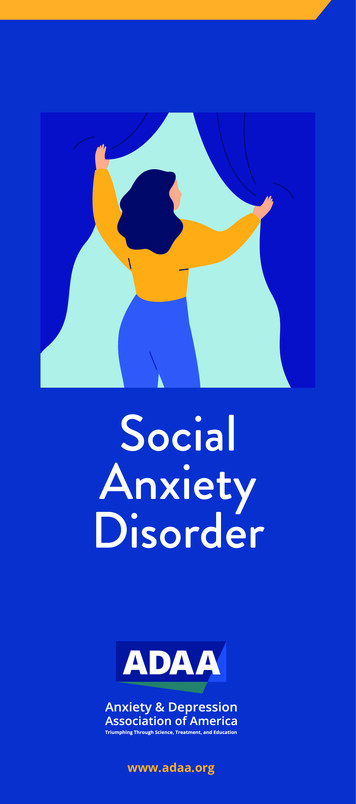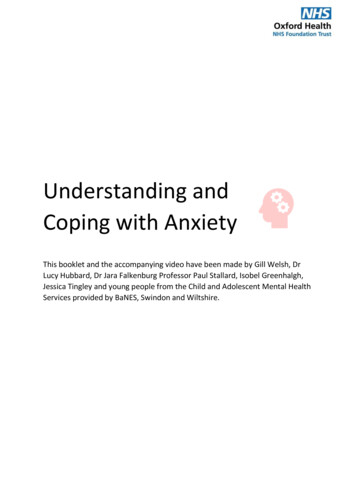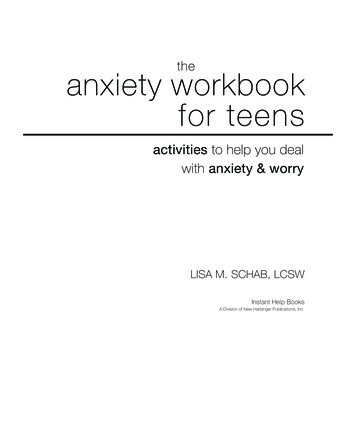
Transcription
theanxiety workbookfor teensactivities to help you dealwith anxiety & worryLISA M. SCHAB, LCSWInstant Help BooksA Division of New Harbinger Publications, Inc.
Publisher’s NoteCare has been taken to confirm the accuracy of the information presented and to describe generally acceptedpractices. However, the author, editors, and publisher are not responsible for errors or omissions or for anyconsequences from application of the information in this book and make no warranty, express or implied, withrespect to the contents of the publication.Distributed in Canada by Raincoast BooksCopyright 2008 by Lisa M. SchabInstant Help BooksA Division of New Harbinger Publications, Inc.5674 Shattuck AvenueOakland, CA 94609www.newharbinger.comCover Design by Amy ShoupIllustrated by Julie OlsonAll Rights ReservedPrinted in the United States of AmericaLibrary of Congress Cataloging-in-Publication DataSchab, Lisa M.The anxiety workbook for teens / by Lisa M. Schab.p. cm.Includes bibliographical references and index.ISBN-13: 978-1-57224-603-4 (pbk. : alk. paper)ISBN-10: 1-57224-603-0 (pbk. : alk. paper) 1. Anxiety in adolescence--Problems, exercises, etc. I. Title.BF724.3.A57S33 2008155.5’1246--dc22200800223810 09 0810 9 8 7 6 5 4 3 2 1
contentsIntroductionvActivity 1About Anxiety1Activity 2The Chemistry of Anxiety4Activity 3Peace Is Already Within You8Activity 4Prevention and Intervention11Activity 5How You Experience Anxiety14Activity 6Your Anxiety Patterns18Activity 7Having an Awesome Attitude22Activity 8Worrying Is Worthless26Activity 9All-or-Nothing Thinking29Activity 10Overgeneralizing33Activity 11“Should” Statements36Activity 12Thought Stopping40Activity 13What’s the Worst That Could Happen?47Activity 14Cost-Benefit Analysis52Activity 15Perfectionism56Activity 16Letting Go of Control60Activity 17Positive Affirmations63Activity 18Serenity, Courage, and Wisdom68Activity 19Seeing the Bigger Picture72Activity 20Talking It Out76Activity 21Writing It Out80Activity 22Eating and Anxiety84Activity 23More Exercise, Less Anxiety89
Activity 24Peaceful Movement93Activity 25Progressive Relaxation98Activity 26Centering Yourself103Activity 27Mindfulness106Activity 28Following Your Breath110Activity 29Deep Breathing114Activity 30Visualization117Activity 31Meditation122Activity 32A Higher Power126Activity 33It’s a Cinch by the Inch130Activity 34Problem Solving135Activity 35Keeping Your Life in Balance140Activity 36Staying Organized143Activity 37Managing Your Time148Activity 38Unexpressed Anger153Activity 39Managing Fears and Phobias158Activity 40Managing Panic164Activity 41Separating Yourself from Other People’s Problems169Activity 42Future Challenges174iv
introductionDear Reader,Welcome to The Anxiety Workbook for Teens. If you have been given this book, it isprobably because you are experiencing anxiety in your life in some way and you arehoping to either get rid of it or learn how to handle it.If you are experiencing anxiety, you are normal. There is no one who doesn’t feelanxious at some time. It is even more common to feel anxious during adolescence,because so many changes are taking place in your body, your mind, and youremotions.Anxiety is a common and very treatable condition. Working through the activities inthis book will give you many ideas on how to both prevent and handle your anxiety.Some of the activities may seem unusual at first. You may be asked to try doing thingsthat are very new to you. Even if the suggestions seem really different from what youare used to, I encourage you to give them a try. The idea that seems the strangest mayturn out to be the one that helps the most.You will also find that, while some activities work very well for you, others don’t helpat all. That is normal, too. You are a unique person, and you will have to discover theactivities that work the best for you. Please feel free to talk with a counselor or otheradult about altering the activities in some way if you find a better method than issuggested here. Be creative, and trust your intuition about what feels good to you andwhat doesn’t.As you complete the exercises, there will be times when you are asked to draw. Manypeople get intimidated when they read the word “draw.” They think that they aren’tgood at art and might be embarrassed by their attempts. Please be aware that there areno right or wrong ways to draw your answers. The purpose of drawing in this book isonly to lead you to a better understanding of yourself and your anxiety.There is one thing that the activities have in common: they won’t help if you do themjust once. They are tools, intended for you to carry with you and use over and over
throughout your life. The more you practice using them, the better you will become atmanaging anxiety.Try to be patient with yourself as you take steps along your path to peacefulness. Itmay take time to find your answers, but be assured that they are there! You will findthem as long as you stay on the path.Lisa M. Schab, LCSWvi
about anxiety1you need to knowAnxiety is a common feeling usually described as “uneasiness”or “apprehension.” At one time or another, everyone experiencesanxiety. It is highly treatable and manageable.The feeling of anxiety has been described with many different words. Here are someof them:stressedginessapprehensionthe jittersworryjumpinessnervousnessthe shakesfearbutterfliesuneasinessfreaking outpanicdisquietagitationangstWhile everyone experiences anxiety, some of us feel it more often, some more deeply,some less frequently, and some less intensely. Your own experience of anxiety willdepend on:1.Genetics—how your parents, grandparents, and ancestors experienced anxiety2.Brain chemistry—the type, amount, and movement of the chemicals working inyour brain3.Life events—the situations you are faced with in your life4.Personality—how you look at and interpret things that happen to youGenetics, brain chemistry, and life events are factors that you have little or no controlover. Your personality, or the way you perceive and handle life events, is somethingyou have a great deal of control over—probably more than you realize. For that reason,most of the activities in this book will focus on working with your personality, helpingyou to understand the way you look at and respond to life and suggesting ways to doit that will help you to lower your anxiety level.1
activity 1 Q about anxietydirectionsYour closest ancestors are your mother, father, grandparents, and great-grandparentson both sides of your family. In person, by phone, or in writing, interview as many ofthese people as you can. Ask them the following questions and record their answerson separate sheets of paper.1.Which of the following words would you use to describe anxiety? (Read orshow them the list on the preceding page.)2.Would you describe yourself as a highly anxious, moderately anxious, or rarelyanxious person, and why?3.Explain how you experience the feeling of anxiety in your body, mind, andemotions.4.Explain what you do to manage anxiety when you feel it.5.Describe how any or all of your responses may have changed over the course ofyour life.Now ask yourself the same questions and record your answers here:1.2.3.4.5.2
activity 1 Q about anxietymore to doLook back over the answers to your relatives’ interview questions. Describe anypatterns you see in the answers.How do your relatives’ answers compare to your answers?What, if anything, do you better understand about yourself in relation to anxiety byhaving learned about your relatives?3
2the chemistry of anxietyfor you to knowOur bodies respond to anxious thoughts by emitting stresshormones. This built-in biological reaction is called the fight-orflight response.In prehistoric times, humans faced challenges different from those they face today. Forexample, a common challenge for prehistoric man may have been to walk outside hiscave in the morning and find himself face-to-face with a huge, hungry lion.Human bodies are miraculous creations that are programmed to survive. Whenconfronted with a threat such as a lion, the brain would send the signal, “Threat!”and the body would respond by shooting hormones, such as adrenaline, into thebloodstream at lightning speed. That made the body immediately stronger and fasterso the human could either wrestle the lion (fight) or run away very fast (flight). Whenhumans either fought or ran away, the physical exertion would disperse the hormones,and the body chemistry would quickly return to normal.In today’s world, our bodies still release stress hormones when we are faced with athreat. The chemical release raises our blood sugar, heart rate, blood pressure, andpulse; slows our digestion; dilates our pupils; and causes us to breathe more shallowly.While these changes prepare us for fast action, we don’t usually take it, so ourhormones don’t disperse. You may become anxious when you look at the history testyour teacher has just handed you and realize you don’t know any of the answers, butyou are not likely to respond by fighting with the history teacher or running from theclassroom. As you sit at your desk “stewing,” the anxiety just continues to build. Builtup anxiety makes us vulnerable to emotional and physical problems. To stay healthy, wehave to find ways to avoid or disperse those chemicals.4
activity 2 Q the chemistry of anxietydirectionsIn the space below, draw a picture of yourself standing at the door of your bedroomfirst thing in the morning. Outside your bedroom door, draw or write all of thechallenges you are confronted with on an average day that might cause your body toemit stress chemicals.5
activity 2 Q the chemistry of anxietymore to doLook at your picture of daily challenges. Write them here in the order of how anxiousthey make you feel. Write those that make you feel most anxious first and those thatmake you feel least anxious last.Describe the physical symptoms you experience when you feel anxious about any ofthese things.6
activity 2 Q the chemistry of anxietyOur bodies emit flight-or-flight response chemicals whether the threat we perceive isinternal, external, real, or imagined. Which challenges in your picture are:internal?external?real?imagined?Do you react by physically fighting or physically running away from any of these threats?Describe how you react if you don’t fight or run away.Describe any realistic ideas you have about how you could release the buildup of stresshormones from your body.7
3peace is already within youyou need to knowMany people think that peace is something we have to look foroutside of ourselves or work very hard to create within ourselves.Actually, peace is a natural state of being that is already withinus; it is just hidden by all of the stress and tension we take in andfocus on.When the renowned fourteenth-century artist Michelangelo was asked how he createdthe exquisite and powerful statue of David from a solid piece of marble, he replied thatDavid was already in the stone; he simply chipped away the excess. Like the statue ofDavid, your peace is already within you. You simply need to unearth it by peeling offthe layers of anxiety that are covering it up.You cover up your peace every time you think of, or dwell on, a stressful thought. Thethought does not destroy your peace, but it can cause you to forget it if you continue todwell on the anxiety.8
activity 3 Q peace is already within youdirectionsShade in the pictures of the floating clouds below with a pale blue crayon or anotherlight color. The clouds represent your natural state of peace. Then take a few minutesto sit quietly, breathe slowly, look at those peaceful clouds, and feel that deep relaxationwithin you.Next, using a darker color, cover up the clouds by writing the names of people,situations, or things that make up the anxiety in your life. Write as many stressfulthings as you can think of.9
activity 3 Q peace is already within youmore to doWhen you looked at the shaded clouds, were you able to feel the peacefulness theyrepresented? If you were, write about what that was like. If not, tell what you thinkprevented you from feeling it.Tell what it was like for you to cover up the peaceful clouds with stressful thoughtsand words.Think about how you cover up your own natural state of relaxation when you chooseto dwell on anxious thoughts. Describe a time when you remember feeling calm butlost sight of that feeling when you began to think anxious thoughts.As you go through the rest of the week, be aware of the times that you cover up yournatural state of relaxation with tension.10
prevention and intervention4for you to knowThere are two ways to work on managing anxiety. The first is bypracticing prevention, which means that you spend time doingrelaxation techniques on a regular basis to keep your everydayanxiety at a low level. The second is by practicing intervention: atthe time you feel your anxiety level rising, you perform a relaxationtechnique to help you calm down and manage the currentsituation.Some people don’t understand why they should practice relaxation techniques beforethey are feeling anxious. To help you understand why it is a good idea, think aboutyour teeth. Do you wait until you have a cavity to start brushing your teeth? Mostof us brush our teeth every day because it helps prevent cavities from forming. It isthe same with anxiety. If you practice relaxation techniques every day, you can betterprevent anxiety from forming.Some of the relaxation techniques you will learn in this book are best used forprevention, before you feel anxiety, and some are best used for intervention, at thetime you feel anxiety. Many of the techniques can be used at both times. It is importantto remember that the more you practice the techniques as prevention, the better youwill be able to use them for intervention.11
activity 4 Q prevention and interventiondirectionsPut a “P” next to the phrases that describe activities done as prevention (before asituation or event) and an “I” next to the phrases that describe activities done asintervention (at the time of a situation or event).Studying for a testRecalling information at the time of a testEating a variety of healthy foods dailyDrinking juice when you have a coldSlamming on your brakes to avoid an accidentDriving at the speed limitSetting your soda can on a coasterCleaning soda rings off the coffee tableWashing your face on a daily basisApplying acne cover-up when your face breaks outSaving part of your allowance or paycheck each weekAsking your parents for a loan when you need extra moneyPutting gas in your car when the gauge reads emptyPutting gas in your car when the gauge reads one-quarter fullBringing a granola bar in your backpack in case you get hungryBuying a granola bar at a vending machine when you get hungryPaying your cell phone bill by the due datePaying your cell phone bill when your service gets turned offWearing a wristguard when you go bowlingDoing wrist-strengthening exercises twice a week12
activity 4 Q prevention and interventionmore to doDescribe three activities you have done in the past week that could be consideredprevention.1.2.3.Describe three activities you have done in the past week that could be consideredintervention.1.2.3.Describe a situation in which your intervention would have been better if you had alsopracticed prevention.Describe any activities you already do to prevent your anxiety level from getting too high.Describe what you usually do to help yourself when your anxiety level gets very high.13
5how you experience anxietyfor you to knowThe way you experience anxiety may be different from the wayyour friend or relative experiences it. Increasing your awareness ofhow you experience anxiety can help you to manage it.Marcus, Danielle, and Emily all experience “test anxiety.” Whenever they have a bigtest coming up in school, they start to feel very anxious. Even though all three of themhave this reaction, they all experience anxiety in different ways.Marcus always has a hard time sleeping for a couple of nights before a test. He finds ithard to fall asleep because his mind is racing with thoughts about the subject he hasbeen studying, the facts he is trying to memorize, what he thinks the essay questionswill be, whether he studied enough, and whether he studied the right materials. Evenwhen he finally falls asleep, he wakes up frequently and often dreams about being latefor class on the day of the test or not knowing any of the answers.Danielle has no trouble sleeping before a test, but she tends to get “knots” in herstomach. She doesn’t have much of an appetite because the muscles in her stomacharea feel very tight, which prevents her from feeling hunger pangs. She has to forceherself to eat tiny meals or snacks even though she’s not hungry, because if she doesn’t eatshe gets light-headed.Emily experiences test anxiety as an overall nervousness. She finds it hard toconcentrate and has a constant sense of uneasiness. She tends to get lost in herthoughts and feels jumpy or antsy. She notices that her heart seems to beat a littlefaster and her breathing is shallower during the morning of a test.Recognizing their anxiety helps Marcus, Danielle, and Emily know what is happeningwhen they feel these symptoms. They realize that they are nervous about the14
activity 5 Q how you experience anxietyupcoming test. The earlier they notice their reactions, the sooner they can practicerelaxation techniques to help alleviate these symptoms and keep them from gettingworse. If they don’t take care of themselves early enough, Marcus might fall asleepduring the test, Danielle would have trouble thinking of the answers because her brainisn’t getting enough nutrition, and Emily could be too distracted to be able to completethe test in the time allowed.15
activity 5 Q how you experience anxietydirectionsThink about the ways you experience anxiety. In the picture below, make notes ormarks on the parts of the body where you feel anxiety symptoms. Use different colors,textures, lines, or shading to help express your feelings more precisely.16
activity 5 Q how you experience anxietymore to doWere you able to remember what anxiety feels like for you? If not, pay attention to howyou experience anxiety over the next week, and then repeat this exercise when youhave more information about yourself.What was it like trying to show your feelings in the picture?When you look back at your body outline again, what are your thoughts and feelingsabout how you experience anxiety?According to the picture, where and how do you feel anxiety the most?How do you think noticing your symptoms when they first begin might be helpfulfor you?17
6your anxiety patternsfor you to knowWhen you understand the thoughts and situations that triggerfeelings of anxiety within you, you can better help yourself toprevent and manage it. A behavior log can help you learn aboutyour anxiety patterns.Alex used to describe himself as a nervous person. He felt like he was more anxiousthan most people, and that made him very shy. He was always afraid he would say ordo something when he was nervous that would make him look stupid or make peoplelaugh at him. He thought he always had to be a little guarded to keep from doing orsaying something embarrassing. There were only a couple of people with whom he feltcomfortable enough to be himself. Alex would have liked to be able to relax enough tomeet more people, but he didn’t know how.His counselor wasn’t sure that Alex’s nervousness was as much of a problem as Alexfelt it was. She asked him to try keeping a behavior log to make him aware of the timesand situations when he experienced anxiety. A copy of part of Alex’s log is shown onthe next page. Alex was surprised to realize that he was highly anxious only in certainsituations with certain people—usually peers whom he perceived as smarter thanhimself. He realized that there were also many times when he felt confident, mainlywith adults, but also with peers that he felt were at his intellectual level. This newknowledge helped give him the courage to better handle the times he did feel anxietyand to take small risks to meet new people.18
activity 6 Q your anxiety patternsAlex’s Behavior LogDayTimeSituationWhat I’m ThinkingMyAnxietyLevelSaturday6 p.m. Meeting my parents’friends who came to ourhouse. I have a 15-minuteconversation with them.These people are nice andeasy to talk to.lowSunday2 p.m. At a baseball game with mydad. Run into some kids Iknow from school. Talk for5 minutes.These kids are in StudentCouncil Club with me. I’msurprised they came overto say hi. Maybe theylike me.mediumMonday4 p.m. Watching my little brother These kids are cute. Iafter school. Helping himknow a lot more thanand his friends practicethey do.batting.lowTuesday11 a.m. Working on group projectin chemistry class.Everyone understands thisstuff better than I do.They probably think I’mstupid.highThursday3 p.m. Sitting on the bus withNathan, the smartest kidin the school.If I open my mouth andsay anything, I’ll sounddumb. I better just sithere and stare out thewindow.high7 p.m. Having pizza at David’shouse.I’m glad David is my bestfriend. He’s fun, and welike the same things.FridaylowdirectionsThe behavior log on the next page gives you a place to record observations about thetimes you feel anxious. Make as many copies as you need and use them to recordinformation about your feelings of anxiety for at least one week.19
activity 6 Q your anxiety patternsMy Behavior LogNameDayTimeWeek ofSituationWhat I’m Thinking20MyAnxietyLevel
activity 6 Q your anxiety patternsmore to doAfter you have filled out the behavior log for a week, answer the following questions:What was it like to pay attention to your feelings of anxiety by keeping this log?Did keeping the log tend to make you more or less anxious? Why?Look back over your log. Describe any patterns you notice over time.Describe any new information you learned about yourself from keeping this log.How can you use this log to help you understand and manage your feelings of anxiety?21
7having an awesome attitudefor you to knowDo you think? If the answer to that question is yes, then you alreadyknow how to use an awesome anxiety-management tool. Yourthoughts create your experience of life. Your attitude, or the wayyou think about things, is one of the most powerful tools you haveto help you prevent and manage feelings of anxiety. And since youare the only one who controls your thoughts, at every momentyou have the ability to create a peaceful experience or an anxiousexperience for yourself.Tristan and Jon were training for their school’s big cross-country meet. They decidedto meet at the field house at noon on Saturday to run a ten-mile course through thesurrounding neighborhoods. Saturday turned out to be the hottest, most humid dayof the summer. The boys laid out their course and then started off. About one-third ofthe way through, both boys were really feeling the heat, but they didn’t want to stopbecause they needed the training. They kept running, getting hotter and thirstier withevery step. By the time they were two-thirds of the way through, all that either of themcould think about was a cool drink of water. When they finally hit the last stretch,they were hotter than ever and their clothes were drenched with sweat. Upon reachingthe school, they both ran straight for the drinking fountain, only to find that it wasn’tworking. There was no drinking water at all except for a half-full water bottle sittingnext to the fountain. Tristan had left it there before they started their run. Both boyslooked at the same water bottle, and both had different reactions.Tristan said, “Oh man! I am so glad I left this water bottle here! It’s just half full, butthat’s better than nothing! Gee, are we lucky to have this!” Tristan’s attitude made himfeel peaceful.22
activity 7 Q having an awesome attitudeJon looked at the very same water bottle and said, “Oh no! I can’t believe this is all wehave! This is terrible! I could drink ten full bottles myself, and all we have is a half ofone!” Jon’s attitude made him feel anxious.Each boy was in the same situation, but each experienced it very differently havingnothing to do with the situation itself. Their experiences came from within each ofthem—from their attitudes.23
activity 7 Q having an awesome attitudedirectionsIn each pair of pictures below, two young people are in the same situation, but youcan tell by the looks on their faces that they are experiencing it differently. Under thepictures, write what each person might be thinking to cause their individual feelings.24
activity 7 Q having an awesome attitudemore to doDescribe a recent situation in which you experienced anxiety.Tell what you were thinking that caused this anxiety.What could you have thought to make the experience a peaceful one instead?Describe a recent situation in which you felt peaceful.Tell what you were thinking that caused you to feel peaceful.What could you have thought that would have made the experience an anxious oneinstead?Read over the two situations you just wrote about. If possible, share them with anotherperson. Think and talk about the awesome power of your attitude to affect how youexperience life.As you go through the upcoming days, notice how your attitude about anything thathappens affects your anxiety level.25
8worrying is worthlessfor you to knowIt is common for people to worry about things that they feel anxiousabout. However, all the time and energy that is spent in worry isactually wasted. When you try to alleviate anxiety by worrying, allyou do is make the anxiety grow stronger.Most people don’t realize why they worry. They think worrying is something that justhappens. Or they say they “have to” worry about something. That is not true, ofcourse. Usually we begin to worry because we feel anxious about a situation andwe want to do something to try to prevent a negative outcome. If it is a situationthat we have little or no control over, there is not much we can do. Not being ableto do anything brings up feelings of helplessness, which trigger worry. Worrying issomething we can do. When we worry, we may feel we are doing something to try tocontrol the situation.People have worried about things for centuries, but it has never once had a positiveeffect on the outcome of a situation. If there were any possible way that worryingwould help you to relieve anxiety, there would be an exercise in this book teachingyou how to worry and suggesting that you practice it diligently as both prevention andintervention.What worrying does do is to drain you, both emotionally and physically. That makesyour situation worse because you have less energy to handle whatever it is that isgoing on. Then your anxiety level goes up again because you feel even more helpless.26
activity 8 Q worrying is worthlessdirectionsRate your present anxiety level on the scale s10HighlyanxiousNow think of a current situation that is bringing up feelings of anxiety for you. Set atimer for five minutes or keep an eye on a clock. Spend the next five minutes worryingabout this situation. Use all of your skills and past experience in worrying to worry ashard as you can. Think about all the negative ways this situation could turn out. Putas much emotional and physical energy as you can into worrying. Imagine you will begraded on how well you can worry, and try to worry hard enough to get an A .After the five minutes is up, rate your anxiety level again on the scale 27910Highlyanxious
activity 8 Q worrying is worthlessmore to doWhat was it like to spend five minutes purposely worrying hard about something?How did this purposeful worrying affect your anxiety level?What happens to your body and your mind when you worry so hard?Describe any way that the worrying you just did will have a positive effect on theoutcome of the situation.Describe something you could do instead of worrying that would be more productiveor would help you feel better.28
all-or-nothing thinking9for you to knowAll-or-nothing thinking is the tendency to judge things in extremeor “black-and-white” categories. It is irrational, because in realitythings are never completely one way or the other. Judging yourselfin this way raises your anxiety level. You are always afraid that ifyou don’t achieve perfection (one extreme) you will be a completefailure (the other extreme).Max was usually a straight-A student. He thought of himself as very intelligent. But ifhe received a B on a test or homework paper, he would think, “Now I’m a total failure.”He also thought he had great leadership skills, but when he lost the election for classvice president, he told himself, “Now I’m a zero.” When Max headed the committeefor the class picnic and they ran out of hamburger rolls, Max said, “I’m worthless as aplanner.”This kind of all-or-nothing thinking caused Max to feel anxious before he took on anytask because he was always afraid of not being able to achieve perfection (one extreme)and thus having to label himself as a failure (the other extreme).29
activity 9 Q all-or-nothing thinkingdirectionsNothing in life is completely one extreme (black) or the other extreme (white). Realpeople and situations have different mixes of negative and positive. Reality exists inthe gray area between black and white.The boxes below show that there is a large gray area between the extremes of blackand white. For each category listed, put a mark to show where your own realisticexperience lies.GradesI get the lowest gradethere ever have been.I get perfect grades.FriendsI am a totally selfish friend.I am always a perfectlygenerous friend.FamilyI am a hateful family member
fear butterflies uneasiness freaking out panic disquiet agitation angst While everyone experiences anxiety, some of us feel it more often, some more deeply, some less frequently, and some less intensely. Your own experience of anxiety will depend on: 1. Genetics—how your pa
